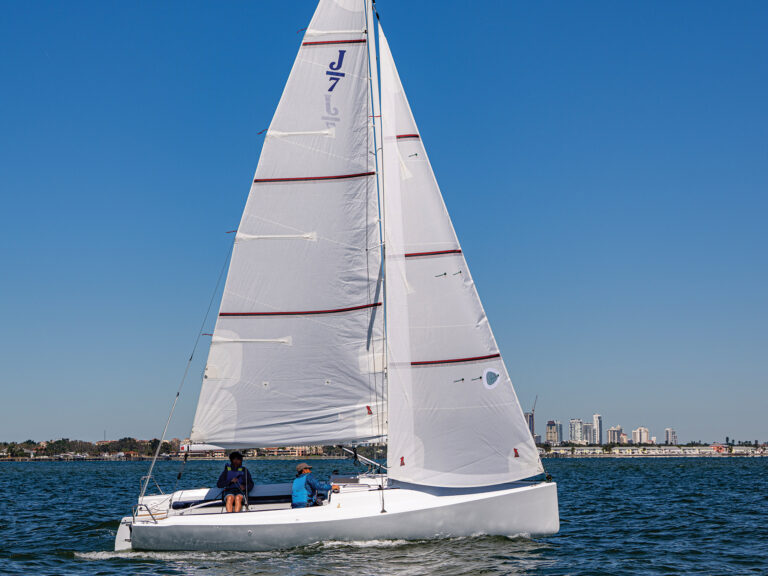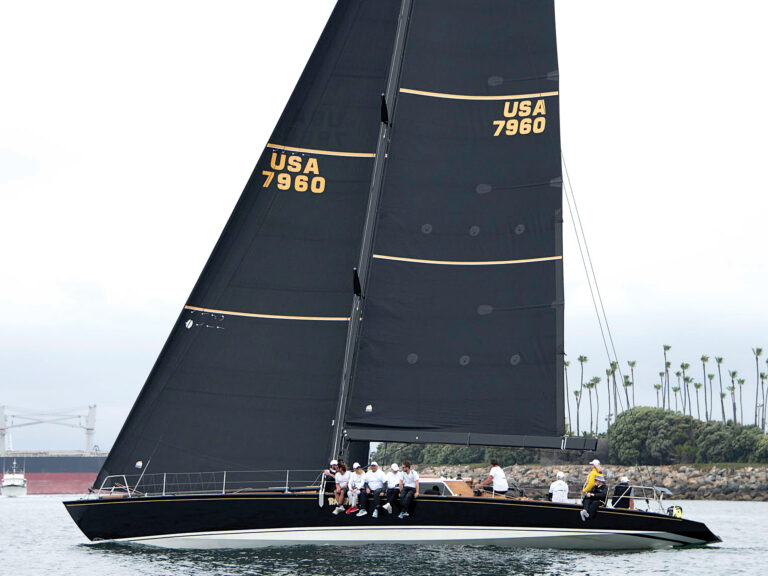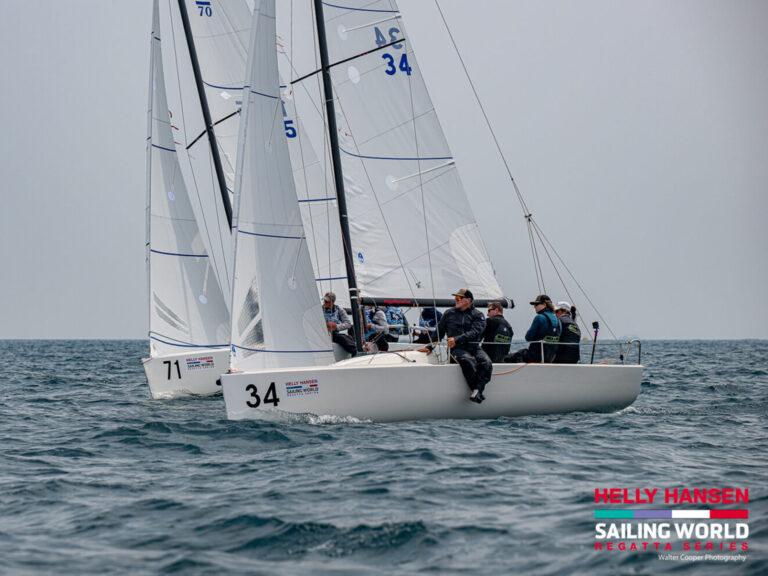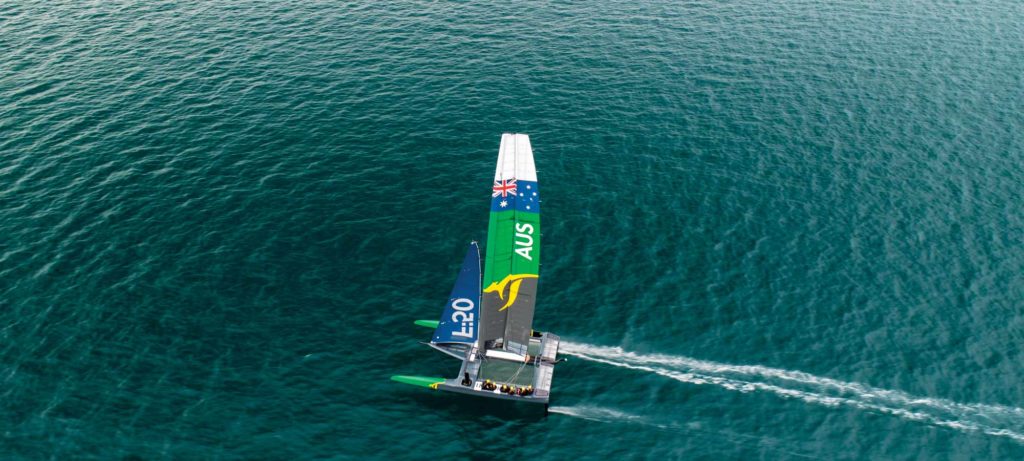
Sustainability is the buzzword today, so Russell Coutts and Larry Ellison are to be commended. They could have easily discarded millions of dollars in technology and hardware from the past two America’s Cups, along with most of the America’s Cup-class monohulls built over the past 20 years. Instead, with their new SailGP pro-sailing circuit, the duo will continue the work they first started in San Francisco and continued in Bermuda.
Cup fans still nostalgic for 12-Meters won’t get excited about SailGP, but the progression of foiling — the most significant development the sport of sailing has ever seen — is exciting. SailGP’s F50 catamarans are a turbo version of the platforms used in Bermuda, and they will no doubt be the fastest one-design class ever created. The AC50’s peak speeds were mid to high 40 knots, but the F50s will peg 55 knots, or possibly more. This third-generation flying cat will foil upwind and deliver airborne maneuvers with greater ease, free from hydraulic power restraints.
The F50 and its new circuit is possible because of Ellison and Coutts’ newfound independence from the America’s Cup and its deed of gift. The circuit sees Ellison generously investing a sizable chunk of his wealth into competitive sailing once again, following three America’s Cup challenges and two defenses. As the world’s fifth-richest man (according to Forbes), Ellison will be paying for the entire show, including SailGP’s infrastructure, its events and every one of its teams. In its entirety. For the next five years. The result will be a supercharged 35th America’s Cup regatta that also includes an international series of events, and significantly for Coutts and Ellison, is free of the politics that dogged their efforts over the past two Cup cycles.
For its first season, in 2019, SailGP will feature five regattas: one each in Sydney; San Francisco; New York; Cowes, England; and Marseille, France. Events will span only two days, showcasing five 20-minute fleet races, which will be followed by a final-race contest between the top two teams. The season finale, to be contested in Marseille, will feature a different format: three days of racing, with the winner receiving a $1 million purse.
The race format, management tools and umpiring will be similar to the America’s Cup in Bermuda, including reaching starts, course boundaries and in-booth umpiring, but improved. In year one, SailGP will have six teams: USA (led by young Oracle Racing alum Rome Kirby), UK (led by Chris Draper, but with Olympic 49er sailor Dylan Fletcher helming), France (Nacra 17 Olympian Billy Besson), Australia (Oracle tactician Tom Slingsby), China (led by Kiwi match-racing ace Phil Robertson) and a team from Japan led by Nathan Outteridge. For crews, there is a strict nationality rule, except for emerging nations like China and Japan, which will be able to sail with foreigners initially but are expected to be 100 percent national after their third seasons.
The F50 flying catamarans are not merely one-design AC50s. They are all identical (save for their wings), but are a major step on from the Bermuda tech, significantly faster on all points of sail. Unlike most one-designs, where technology is more or less locked in time when they’re created, the F50s will be refined and upgraded.
“Look back to the 115-foot trimaran in 2010 and at these things now,” Coutts says. “Development in multihulls has been really dramatic. Technology is rapidly improving, so clearly the boats have to evolve, while also providing close racing.”
To further development, SailGP will maintain its own design team. For example, a major project for 2019 will be developing a new wing. It is proposed that the future wing might have interchangeable midsections, allowing teams three wing sizes (e.g., with 18-, 24- and 28-meter heights). The intention is for them to perform in the widest range of conditions, to minimize lost sailing days due to weather conditions. For example, initially, maximum windspeed will be in the low 20s, but the new wings would enable them to sail into the high 20s.
For Coutts, SailGP is not a new concept. More than a decade ago, he and Paul Cayard pitched the World Sailing League. After a lot of early trumpeting, the circuit never transpired. “We have been thinking about bringing more certainty around a professional sailing league,” Coutts explains. “SailGP offers annual, global, nation-against-nation racing that has commercial viability. Its consistency of format, venues, rules, teams, make it a long‑term venture.”
Major sporting leagues around the world have teams that are both long-established and highly profitable businesses, whether it be the NFL’s Dallas Cowboys (worth $4.8 billion, according to Forbes) or the soccer team Manchester United (worth $4.1 billion). Coutts and Ellison, therefore, would like SailGP teams to go some way toward emulating these franchises. Another analogy is Formula 1, Coutts says. “They go to the same venues every year. They have a structured circuit and can have long-term contracts with partners because of that. People know what an F1 season will look like, so teams can invest in that and can build brands over the long term and gain brand equity. If any owner tires of being involved, their team can be sold and hopefully continue. At present, sailing teams get built, they exist and then disappear. We want to change that.”
Sailing’s longest-established commercial teams are found in France, where companies like Banque Populaire have been backing the sport in a major way for almost three decades. Otherwise, in the America’s Cup arena, Ellison personally played for 17 years, and similarly, Prada boss Patrizio Bertelli has been challenging for 20 years with his Luna Rossa campaigns. Neither has ever been a business. The team perhaps closest to the Coutts-Ellison vision is the one that founded Coutts’ reputation and is today their biggest nemesis: Team New Zealand. While the Kiwi enterprise does have private benefactors, such as Matteo de Nora, it has legacy sponsorship deals with companies such as Emirates airline, Toyota and Omega, which have successfully rolled from one campaign to the next.
With SailGP teams, Ellison has underwritten each to the tune of $5 million per year, with the intention that they will become profitable as soon as possible. Team commercial deals are either carried out centrally through the circuit (e.g., clothing) or via the team principals, often with additional agency help. In the case of the U.S. team, support will come from the marketing firm LeadDog, with offices in San Francisco and New York.
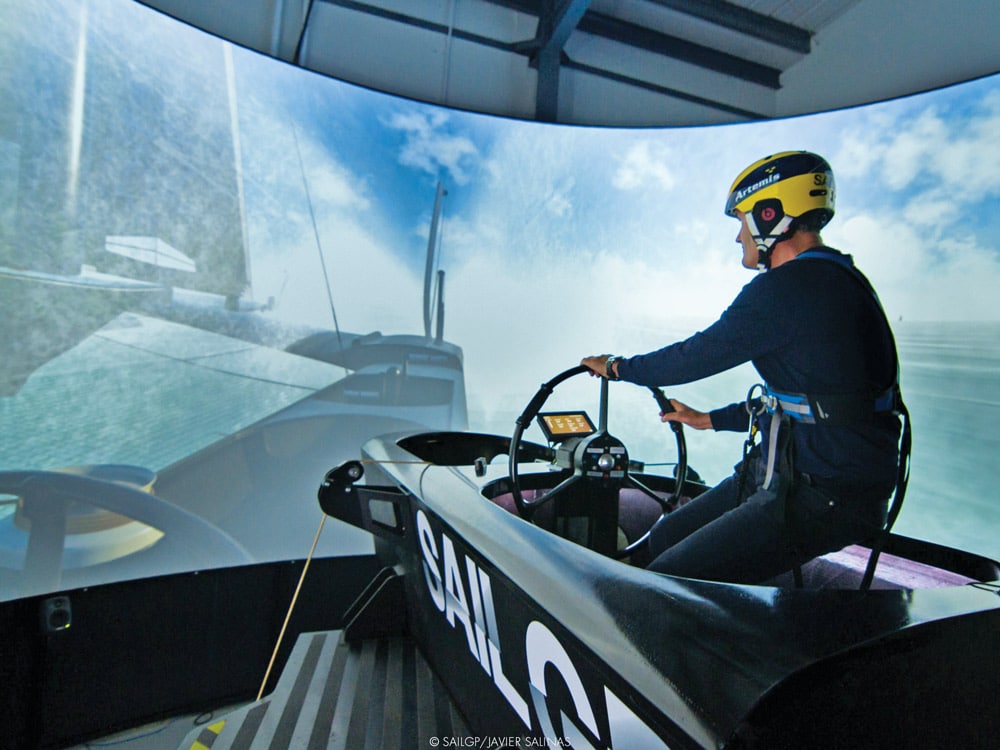
After five years, the intention is to sell off the teams as going concerns. “For its formative stage, we are not going to have any other owners,” Coutts says. “People may come in as sponsors, or they may even have a first option to purchase a team after five years.”
Aside from reasons of therapy after two rounds of running the America’s Cup and all its bartering, this new approach of benign dictatorship allows progress to be made rapidly. In the commercial world, SailGP seems to be already finding favor, with Land Rover and Louis Vuitton announced as partners.
The creation of the initial F50 fleet has been no easy task for project leaders Nick Holroyd and (subsequently) Mike Drummond, plus the legions of specialists and boatbuilders at Core Builders Composites, based in Warkworth, New Zealand, where the transformations were conducted. Many of the AC50 fleet’s components were one-design, but there were many parts that were not — notably the foils, foil-control mechanisms and the wing engineering and controls.
To accelerate the process of creating its initial fleet, SailGP acquired the AC50s of Land Rover BAR, Artemis Racing, Softbank Team Japan and Oracle Team USA. Core built two entirely new boats from Oracle’s molds, and the British and Swedish boats underwent major surgery to become one-design F50s. “Having the old boats saved some time because we kept parts of the hull, etc., but it wasn’t a huge amount of time. We have built six new boats effectively.”
New components include decks, cockpits, main foils, plus their intricate cases and control systems, rudders, sterns, electronics and hydraulics. One fundamental change was fitting a battery-powered system to operate the array of hydraulic controls that adjust almost everything, from the top of wing to the tips of foils. Driving the wing sheet alone ties up two of the F50’s five crew with grinding. The remaining three positions are helmsman, wing trimmer (also jib trimmer) and flight controller. There are variations in the roles. For example, the flight controller can trim the rake of the leeward foil to adjust ride height, but the helmsman can as well, via a twist grip on the wheel.
The F50’s batteries are specified to last a full day of racing. They will drive the boat’s multitude of hydraulic pumps either directly or via the hydraulic accumulators as were used on the AC50s. These accumulators permit very high, instantaneous power, vital for actions like fast foil deploys during tacks. For example, they allow eight to 10 seconds of accumulated power to be released in half a second.
A significant flaw of the AC50 was the constant depletion of hydraulic power. At best, this prevented crews from maneuvering, and at worst, it was unsafe. The F50’s battery power solves this and should dramatically improve the racing, leaving crews unconstrained by the number of tacks or jibes they wish to carry out. As Coutts puts it, “Now they’ll be able to tack more regularly for tactical reasons or if there is a significant wind shift. They will still lose from it, but much less than before. That will improve the quality of the racing a lot.”
One of the principle reasons why F50s will be faster than AC50s is due to the new foil package. One of the AC50’s limitations was a rule that restricted both the geometry of the foils and construction materials. As a result, the AC50’s foils would cavitate when boatspeed neared the 40s, physically limiting its absolute top speed to around 48 knots. The new F50 boards are built of a higher-modulus carbon fiber, and their gentler curvature means that the onset of cavitation now happens at 48 knots, enabling an incredible top speed well into the mid-50s in 16 knots of wind and upward. Each F50 has a set of light-wind and heavy-wind foils, and both have a higher cavitation speed than the original AC45 boards.
If AC35 was made for television, SailGP walks even further down this route, with its tight schedule and races taking place late in the day when it will conceivably draw more viewers. “The assumption that we will carry on producing what we did at AC35 is not what we are doing,” Coutts says. “We are completely charging that up. It will look quite different to the AC35 product.”
For example, they will use a new production company, Whisper Films, which produces the television offering for Formula 1. Stan Honey’s LiveLine augmented-reality graphics have been improved, and there will be increased use of camera drones (in addition to helicopters) during racing. “Imagine a cross being filmed by a drone just above wing height. Those would be pretty spectacular images,” Coutts says. “But now that we have no secrecy around the boats, all of the data coming off the boats can be in the public domain, and we can drill into, for example, why one helmsman is outperforming another, how they are steering and controlling the boat. We will have all that data and be able to use it.”
While the AC35 had shore-based umpiring, Coutts also envisioned shore-based coaches being able to offer advice to the skipper (much like F1 teams talking with their drivers) during racing. These conversations will be incorporated into the television offering, as they are in F1.
With the first F50 launching at the end of October, teams struggled to get in adequate training time. However, in another example of repurposed AC technology, Artemis Technologies developed a full-scale simulator in which SailGP crews can train. Surrounded by a wraparound screen onto which their virtual sailing environment is projected is the cockpit of an AC50. This is mounted on an array of hydraulic rams that re-create the movement the crews can expect. On board, three crew (i.e., no grinders) operate all of the functions just as they would on the real F50, and the visuals are complete enough for the sailors to see rake of the leeward foil changing and feel a wipeout when they get it wrong and stuff the bows. Aside from crew training, the simulator also holds a significant role as a design tool, particularly for Artemis Technologies, to trial systems before being fitted to the real F50.






